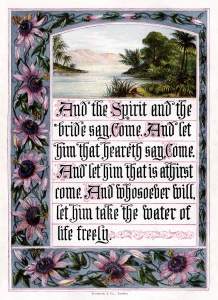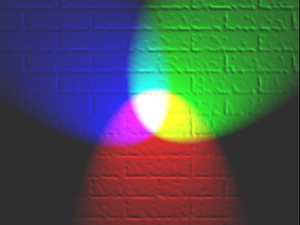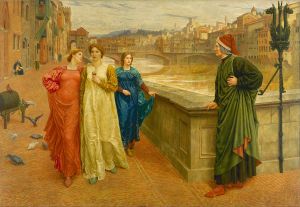This post explores the identity of Disiri and her role in the WK’s themes.
Disiri, like most characters in the WK, is based on multiple sources. And Able’s pursuit of her has multiple meanings. GW uses mythology, legend, Kabbalah and Christianity in developing this theme.
Disiri in Arthurian Legend and Mythological Terms
Disiri’s Arthurian counterpart is the Lady of the Lake. In some stories, the Lady took Lancelot to live in her fairy world for some time to protect him. In the WK, Disiri takes both the Real Able and Able/Art to Aelfrice.
As MAD identified in his WKC, Disiri may be associated with the Dis of Norse mythology.
Disiri’s Celtic/British counterpart is Brigid. Brigid was the patroness of poets, smiths and sacred wells. This fits very well with the events of the WK:
- Disiri tells Able the story of Weland the Smith and the forging of Eterne.
- Eterne is found in a deep well.
- The “names on the wind” that Able hears near the end of The Knight include many poets and writers of the medieval period.
I think Disiri’s counterpart from Greek mythology may be Eurydice. This might be another example of GW moving syllables around and tweaking spelling to hide an identity. If you move the syllables Eurydice becomes “Diceeury”, which sounds somewhat like Disiri. Eurydice was a dryad or nymph, and linked to the legend of Orpheus. Disiri refers to herself early in The Knight as a dryad. Able is also a representation of Orpheus, and his bowstring is an allusion to the Lyre of Orpheus. Orpheus and Eurydice end up together in the underworld, which is consistent with the ending of the WK.
Disiri as Beatrice
The WK is strongly influenced by Dante’s Divine Comedy. Art Ormsby’s wandering in the woods at the beginning of the WK is like Dante’s wandering in the wilds at the beginning of the Comedy. Able sees a the castle in the sky he wants to pursue, and gets lost. Similarly, Dante loses his way in a dark wood while trying to get to salvation at the beginning of the Inferno. The six sided castle of Skai reminds me of the seven sided Castle in Limbo where the virtuous pagans live in relative peace and comfort.
One of Dante’s guides in the Comedy is Beatrice, who was based on a woman he knew in real life. She is an idealized feminine, and helps him to achieve the Beatific vision, or union with God. Beatrice sends Dante his first guide, the poet Virgil. Disiri has a somewhat similar role in the WK as Beatrice in the Divine Comedy. Able loves Disiri, as Dante loved Beatrice. They are the ideal feminine for both, and something that draws the characters onwards towards a resolution.
Disiri and Color, Plant and Animal Symbolism
Green, Yellow and the Language of Flowers
Disiri has green skin and hair, and yellow eyes. I think this has multiple meanings in traditional color symbolism and the Kabbalah color scheme. Green alone, and sometimes green and yellow together (depending on what Kabbalah website I read) are the colors of the Sefirot Binah. Binah is associated with the feminine and wisdom.
While green is considered a positive color, yellow often has negative associations in Western culture. Yellow can be the color of cowardice. It can be the color of deceit (“yellow journalism”). Yellow has a negative meaning in plant symbolism and the “Language of Flowers.” Yellow roses are sometimes associated with betrayal and treachery. Yellow carnations can mean rejection. The yellow Marigold can mean pain or grief (think Lynnet). Disiri’s actions, at times, seem to represent infidelity or betrayal of Able. Morcaine questions whether Disiri is faithful to Able (at Redhall in “Morcaine and More Magic”) and Able seems to acknowledge that she is not.
The Eyes of a Leopard
Able describes Disiri as having eyes like a leopard in Chapter 7 of The Knight. A leopard was one of three beasts that threatened Dante in the opening chapters of the Inferno, and is portrayed negatively there. There are other sources that suggest that the leopard was viewed negatively in the Christian tradition, and associated with sin.
Disiri is relatively unconcerned with the lives of Able’s friends, acknowledging she cannot love them the way Able loves them. She does not come to his aid when he is imprisoned, and her affection seems fickle at times. Able describes her as “hard and dangerous” near the end of The Knight.
Disiri’s Color Transformation
At the end of the WK, Disiri drinks Able’s blood (red), and loses her yellow coloring. Her eyes change to green, and her skin takes on normal human skin tones. The vanishing of the yellow is consistent with this being a positive transformation. The color green is associated with life and hope in the Christian tradition, and maybe that’s what her new eyes are to signify.
The Mystical Union of Kabbalah
Able and Disiri are a representation of the mystical union in the Kabbalah between YHWH and the Shekhinah. The achievement of this union is signalled by the reconciliation of the Men and Women of Celidon in the union of many of the protagonists. This reconciliation was accomplished in a mystical way by Able’s achievement of the Holy Grail and the Golden Fleece when he entered the Room of Lost Loves. I previously associated the Spiny Orange tree with the Sefirot Yesod. Yesod’s colors in Kabbalah are understood to be orange (again, in at least some websites. There is some inconsistency). Yesod is also associated with the sexual organs.
Disiri as the Bride of Christ
Finally, and consistent with the Christian Allegory, Able is a representation of Christ in the WK. Disiri, in turn, represents the Church, or humanity. He is the Bridegroom and she is the Bride. Like Disiri, humanity in the Christian tradition is fickle, unfaithful, and inconstant. Man must partake of Jesus’ flesh and blood to have eternal life, as Disiri must drink from Able for the Aelf to develop further in accord with the Most High God and Kulili’s plan. And like Psyche drank ambrosia to have immortality and a true relationship with Cupid. Able and Disiri will share this water of life with those in Aelfrice.
I will close this post with the image used to illustrate a passage from Revelation associated with the Bride. Dawn in Aelfrice?
Joseph Martin Kronheim, illustration of Revelation 22:17 (public domain).



